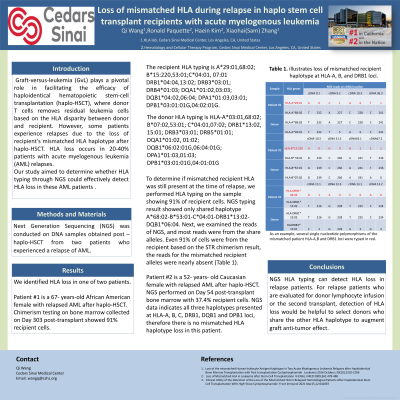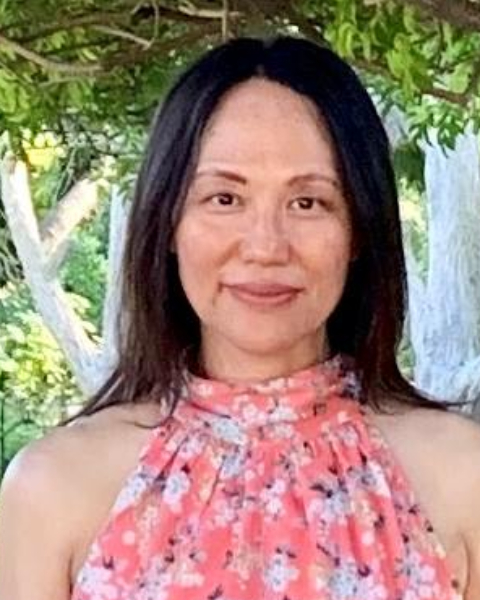Back

(P406) Loss of mismatched HLA during relapse in haplo stem cell transplant recipients with acute myelogenous leukemia
Location: Platinum Ballroom

Poster Presenter(s)
Body: Graft-versus-leukemia (GvL) plays a pivotal role in facilitating the efficacy of haploidentical hematopoietic stem-cell transplantation (haplo-HSCT), where donor T cells removes residual leukemia cells based on the HLA disparity between donor and recipient. However, some patients experience relapses due to the loss of recipient’s mismatched HLA haplotype after haplo-HSCT. HLA loss occurs in 20-40% patients with AML relapses.
Here, we examined if HLA typing by Next Generation Sequencing (NGS) can detect HLA loss in AML relapse patients. We identified HLA loss in one of two patients.
Patient #1 is a 67- years-old African American female with relapsed AML after haplo-HSCT. Chimerism testing on bone marrow collected on Day 303 post-transplant showed 91% recipient cells. The recipient HLA typing is A*29:01,68:02; B*15:220,53:01; C*04:01,07:01; DRB1*04:04,13:02; DRB3*03:01; DRB4*01:03; DQA1*01:02,03:03; DQB1*04:02,06:04; DPA1*01:03,03:01; DPB1*03:01:01G,04:02:01G. The donor HLA typing is HLA-A*03:01,68:02; B*07:02,53:01; C*04:01,07:02; DRB1*13:02,15:01; DRB3*03:01; DRB5*01:01; DQA1*01:02,01:02; DQB1*06:02:01G,06:04:01G; DPA1*01:03,01:03; DPB1*03:01:01G,04:01:01G.To determine if mismatched recipient HLA was still present at the time of relapse, we performed HLA typing on the sample showing 91% of recipient cells. NGS typing result showed only shared haplotype A*68:02-B*53:01-C*04:01-DRB1*13:02-DQB1*06:04. Next, we examined the reads of NGS, and most reads were from the share alleles. Even 91% of cells were from the recipient based on the STR chimerism result, the reads for the mismatched recipient alleles were nearly absent (Table 1).
Patient #2 is a 52- years- old Caucasian female with relapsed AML after haplo-HSCT. NGS performed on Day 54 post-transplant bone marrow with 37.4% recipient cells. NGS data indicates all three haplotypes presented at HLA-A, B, C, DRB1, DQB1 and DPB1 loci, therefore there is no mismatched HLA haplotype loss in this patient.
Conclusion: NGS HLA typing can detect HLA loss in relapse patients. For relapse patients who are evaluated for donor lymphocyte infusion or the second transplant, detection of HLA loss would be helpful to select donors who share the other HLA haplotype to augment graft anti-tumor effect.
Here, we examined if HLA typing by Next Generation Sequencing (NGS) can detect HLA loss in AML relapse patients. We identified HLA loss in one of two patients.
Patient #1 is a 67- years-old African American female with relapsed AML after haplo-HSCT. Chimerism testing on bone marrow collected on Day 303 post-transplant showed 91% recipient cells. The recipient HLA typing is A*29:01,68:02; B*15:220,53:01; C*04:01,07:01; DRB1*04:04,13:02; DRB3*03:01; DRB4*01:03; DQA1*01:02,03:03; DQB1*04:02,06:04; DPA1*01:03,03:01; DPB1*03:01:01G,04:02:01G. The donor HLA typing is HLA-A*03:01,68:02; B*07:02,53:01; C*04:01,07:02; DRB1*13:02,15:01; DRB3*03:01; DRB5*01:01; DQA1*01:02,01:02; DQB1*06:02:01G,06:04:01G; DPA1*01:03,01:03; DPB1*03:01:01G,04:01:01G.To determine if mismatched recipient HLA was still present at the time of relapse, we performed HLA typing on the sample showing 91% of recipient cells. NGS typing result showed only shared haplotype A*68:02-B*53:01-C*04:01-DRB1*13:02-DQB1*06:04. Next, we examined the reads of NGS, and most reads were from the share alleles. Even 91% of cells were from the recipient based on the STR chimerism result, the reads for the mismatched recipient alleles were nearly absent (Table 1).
Patient #2 is a 52- years- old Caucasian female with relapsed AML after haplo-HSCT. NGS performed on Day 54 post-transplant bone marrow with 37.4% recipient cells. NGS data indicates all three haplotypes presented at HLA-A, B, C, DRB1, DQB1 and DPB1 loci, therefore there is no mismatched HLA haplotype loss in this patient.
Conclusion: NGS HLA typing can detect HLA loss in relapse patients. For relapse patients who are evaluated for donor lymphocyte infusion or the second transplant, detection of HLA loss would be helpful to select donors who share the other HLA haplotype to augment graft anti-tumor effect.

